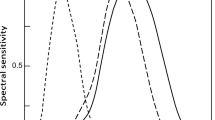Abstract
This paper concerns the processing of the outputs of the two opponent-color mechanisms in the human visual system. We present experimental evidence that opponent-color signals interact after joint modulation even though they are essentially independent under neutral steady adaptation and after exclusive modulation of each mechanism. In addition, prolonged modulation linearizes the response function of each mechanism. The changes in interaction serve to orthogonalize opponent signals with respect to the adapting modulation, and the changes in response functions serve to equalize the relative frequencies of different levels of response to the adapting modulation. Adaptive orthogonalization reduces sensitivity to the adapting color direction, improves sensitivity to the orthogonal direction, and predicts shifts in color appearance. Response equalization enhances effective contrast and explains the difference between the effects of adaptation to uniform versus temporally or spatially modulated stimuli.
Similar content being viewed by others
References
Atick JJ, Li Z, Redlick AN (1993) What does post-adaptation color appearance reveal about cortical color representation? Vision Res 33:123–130
Barlow HB (1969) Pattern recognition and the responses of sensory neurones. Ann NY Acad Sci 156:872–881
Barlow HB (1990) A theory about the functional role and synaptic mechanism of visual after-effects. In: Blakemore C (ed) Vision: encoding and efficiency. Cambridge University Press, pp 363–375
Barlow HB, Foldiak PF (1989) Adaptation and decorrelation in the cortex. In: Durbin RM, Miall C, Mitchison GJ (eds) The computing neuron. Addison-Wesley, New York, pp 54–72
Boynton RM, Nagy AL, Eskew RT Jr (1986) Similarity of normalized discrimination ellipses in the constant-luminance chromaticity plane. Perception 15:755–763
Craik KJW (1938) The effect of adaptation on differential brightness discrimination. J Physiol 92:406–421
Derrington AM, Krauskopf J, Lennie P (1984) Chromatic mechanisms in lateral geniculate nucleus of macaque. J Physiol 357:241–265
Flanagan P, Cavanagh P, Favreau DE (1990) Independent orientationselective mechanisms for the cardinal directions of color space. Vision Res 30:769–778
Gegenfurtner K, Kiper D (1992) Contrast detection in chromatic and luminance noise. J Opt Soc Am [A] 9:1880–1888
Gonzalez RC, Wintz P (1987) Digital image processing, Addison-Wesley, Reading, Mass
Greenlee MW, Heitger F (1988) The functional role of contrast adaptation. Vision Res 28:791–797
Helmholtz H von (1925) Physiological optics, vol. 3. Optical Society of America, Washington
Judd DB (1932) Chromaticity sensibility to stimulus differences. J Opt Soc Am 22:72–108
Kohonen T (1984) Self-organization and associative memory. Springer, Berlin Heidelberg New York
Kohonen T, Oja E (1976) Fast adaptive formation of orthogonalizing filters and associative memory in recurrent networks of neuron-like elements. Biol Cybern 21:85–95
Krauskopf J, Zaidi Q (1985) Spatial factors in desensitization along cardinal directions of color space. Invest Ophthalmol Vis Sci 26:206
Krauskopf J, Zaidi Q (1986) Induced desensitization. Vision Res 26:759–762
Krauskopf J, Williams DR, Heeley D (1982) Cardinal directions of color space. Vision Res 22:1123–1131
Krauskopf J, Williams DR, Mandler MB, Brown AM (1986a) Higher order color mechanisms. Vision Res 26:23–32
Krauskopf J, Zaidi Q, Mandler MB (1986b) Mechanisms of simultaneous color induction. J Opt Soc Am [A] 3:1752–1757
Laughlin S (1981) A simple coding procedure enhances a neuron's information capacity. Z Naturforsch 36:910–912
Le Grand Y (1949) Le seuils differentials de coleurs dans la theorie de Young. Rev Opt Theo Inst 28:261–278
Lennie P, Krauskopf J, Sclar G (1990) Chromatic mechanisms in striate cortex of macaque. J Neurosci 10:649–669
MacLeod DIA, Boynton RM (1979) Chromaticity diagram showing cone excitation by stimuli of equal luminance. J Opt Soc Am [A] 69:1183–1186
McCollough C (1965) Color adaptation of edge-detectors in the human visual system. Science 149:1115–1116
Movshon JA, Lennie P (1979) Pattern-selective adaptation in visual cortical neurones. Nature 278:850–852
Press W, Flannery B, Teukolsky S, Vetterling W (1988) Numerical recipes in C: the art of scientific computing. Cambridge University Press, New York
Rosenfeld A, Kak AC (1982) Digital picture processing. Academic Press, New York
Sachtler W, Zaidi Q (1992) Chromatic and luminance signals in visual memory. J Opt Soc Am [A] 9:877–894
Sclar G, Lennie P, DePriest DD (1989) Contrast adaptation in striate cortex of macaque. Vision Res 29:747–755
Shapiro AG, Zaidi Q (1992a) Prolonged temporal modulation and the interaction between color mechanisms. Opt Soc Am Tech Digest Ser 23-51
Shapiro AG, Zaidi Q (1992b) The effect of prolonged temporal modulation on the differential response of color mechanisms. Vision Res 32:2065–2075
Smith VC, Pokorny J (1975) Spectral sensitivity of the foveal cone photopigments between 400 and 700 nm. Vision Res 15:161–171
Swain MJ, Ballard DH (1991) Color indexing. Int J Comput Vision 7:11–32
Webster MA, Mollon JD (1991) Changes in colour appearance following post-receptoral adaptation. Nature 349:235–238
Wyszecki G, Stiles WS (1982) Color science, 2nd Edn. Wiley, New York
Zaidi Q (1992) Parallel and serial connections between human color mechanisms. In: Brannan JR (ed) Applications of parallel processing in vision. Elsevier, New York, pp 227–259
Zaidi Q, Halevy D (1991) Chromatic mechanisms beyond linear opponency. In: Valberg A, Lee BB (eds) Pigments to perception. Plenum Press, New York, pp 337–348
Zaidi Q, Halevy D (1993) Visual mechanisms that signal the direction of color changes. Vision Res 33:1037–1051
Zaidi Q, Shapiro A (1992a) Combination of signals from opponent color mechanisms. OSA Adv Color Vision Tech Digest 4:201–203
Zaidi Q, Shapiro A (1992b) Adaptive decorrelation between opponentcolor mechanisms. Perception 21 [Suppl 2]:62
Zaidi Q, Shapiro A, Hood DC (1992) The effect of adaptation on the differential sensitivity of the S-cone color system. Vision Res 32:1297–1318
Author information
Authors and Affiliations
Rights and permissions
About this article
Cite this article
Zaidi, Q., Shapiro, A.G. Adaptive orthogonalization of opponent-color signals. Biol. Cybern. 69, 415–428 (1993). https://doi.org/10.1007/BF01185413
Received:
Accepted:
Issue Date:
DOI: https://doi.org/10.1007/BF01185413




